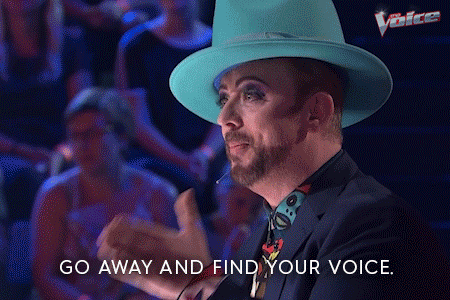
Want to stand out in the nutrition coaching industry? The key is developing your brand voice in a way that is authentic and compelling to your audience. We get it, it can feel scary to find and trust your voice. But, it isn’t as difficult as it may sound or seem.
Setting the Stage
There you are, open laptop, full cup of coffee and a word doc calling you to start typing. You’re ready to put out some compelling, interesting content that will help you cut through the noise in the nutrition and fitness industry and make your prospective clients trust and love you.
But you’re drawing a blank.
What do people actually want to hear? How do you say it in a way that feels like...well, you? Oh, and resonates with everyone else at the same time and makes them think “hey, this guy/gal really knows their stuff”?
Advertisement
Most importantly, how do you ensure that you’re sharing content in a way that not just sells, but reflects what your brand is as a business and becomes recognizable as your own?
Enter – your ‘Brand Voice’.
What is a Brand Voice
A brand voice is the set of values and characteristics used to share anything and everything from you and/or your company.
At WAG, we have many team members who write copy for our website, social channels or external-facing resources. When someone is appointed the responsibility of writing something for WAG, they have to review our brand voice and writing guidelines to ensure that they know how to speak our language and, well, use our voice.
Advertisement
Brand voice and writing guidelines can include everything from how you capitalize your titles (we use title case, if you were wondering), what words you don’t use (a WAGger shouldn’t swear), what tone of voice you write in (sometimes we get a little carried away with exclamation points but we’re working on it) even down to what topics you’re willing to be polarizing or controversial about (some brands are super controversial but as a general rule, we try not to ruffle feathers.)
When your business's brand voice is consistent people know what to expect from it. If people like one thing you have to say, they’re likely to enjoy the rest and become a fan. Better yet, they’re likely to become a customer down the line because they can trust that what they get from you will be in line with what they’ve already seen and heard.
On the flipside, if you’re all over the place with your voice and messaging, people won’t trust you as much and will be less likely to buy from you.
Think about it, if you met someone at a party and they acted one way, then the next three times you met them they were totally different, you’d be a little uneasy. You wouldn’t relate to them and probably wouldn’t trust them.
This is the trick to creating a brand voice. Ask yourself: how do you want people to perceive your brand? Now act that way consistently.
Advertisement
Are you thinking to yourself, “but Dani, when I start to commit to my voice, doesn’t that mean I’m missing out on reaching a lot of people”?
Don’t worry, just because you commit to having one voice doesn’t mean you're alienating everyone else.
The truth is, if you try to speak to everyone you really aren’t speaking to anyone at all. The reality of marketing is that you can’t win everyone's business nor do you want to, so you need to focus on the business that you can win. Dialing in your brand voice is step one.
The other thing to rest easy about is that creating a brand voice will actually make your life easier as a marketing and content creator. Once you’ve settled on who you are, what your brand is, how you talk and what your stance is, talking about and writing for your business becomes super easy.
How to Hone In Your Brand Voice
Advertisement
Let’s go through what you need to hone in on your brand voice. You can start small and expand your brand voice guidelines with time.
1. Who are you? What comes easiest to you?
If you’re a solo-preneur and your brand is largely based around you, the easiest thing to do is write down your own personal characteristics that you’d like to emulate through your brand. This is nice because it means it will come more naturally to you. For example, I’m an Australian so I have a harder time writing in your typical all-American girl next door voice, so my personal brand voice would come across better if I channeled my inner Aussie a little more. Obviously you can’t read accents but you can read colloquialisms.
The other reason I like this example is because the internet is filled with a lot of people copying each other's brand voices, but when you tune into your own personal, real life characteristics, it’s easier to come up with something more original that cuts through the noise. Embrace yourself!
What can you do to settle more into your own personal style that also helps you stand out in the nutrition space? Do you use certain slang when talking about cauli rice or avo toast? Are you super professional and a science-lover when you share about the benefits of protein? Do you LOVE to simplify complex concepts like the way the body utilizes carbs for fuel? Are you a user of big words and phrases like “thermic effect of food”?
Remember that not everyone has to be exactly like you to trust and resonate with you. They just need to like you.
Advertisement
2. What do you value in a brand, especially your own?
Sleek and modern, dark and grungy (hello OG CrossFit days) or bright and airy? Consistent, valuable content? Always speaking out on the issues or focusing solely on what you do best? Inclusivity? Laughter and joy?
Writing a list of these values for your nutrition coaching brand will be a guiding star when you’re wondering if you should or should not be sharing an image, cute caption or longer written piece.
As your brand grows, this becomes more and more important. In the early days it’s ok to try things and decide that it didn’t feel right. When you come across those topics, you can expand upon your values. Remember, of course, to catch any values that wildly contradict each other.
3. What do you write about to your audience?
Now you have your writing style, your personality and your values ready to go...but what do you actually talk about to your audience?!
This is one of the BIGGEST questions we get inside of our Business Program when people are first launching their nutrition coaching businesses and following along with the marketing blueprint we give them. So here’s a quick exercise:
Advertisement
- List all the things in your industry that you think are interesting to potential customers.
For nutrition coaches it’s often weight loss, muscle gain, healthier habits, nutrition facts, hormonal health information, a particular sport, women’s or men’s health, mental and physical transformation – you know, the stuff that made you so passionate about coaching in the first place. - List 10 things in your life that you think could be interesting to people.
This is unique to you, but it could be the fact that you live on a horse ranch (hello real-life Heartland), are dog-obsessed, try a new coffee shop or breakfast joint every week, have some solid parenting tips to share or love to spread how amazing your partner is every week (I do hope you choose the horse ranch but you do you.)
Cull that list down to about 4-5 main topics you think you can write about and share most easily. This is your rotation of things to talk about. So for example you could end up with, muscle gain, sustainable fat loss, track athletics, horse ranch updates and breakfast joints.
Let’s look at WAG for some pillar examples to see this in action.
At WAG we share recipes, transformations and client wins, tips for creating sustainable change in your nutrition, personal development and how to start a nutrition coaching business for yourself. Those are the main pillars that we have a lot to share about.
Now get a little organized with it. Doing all this work to find your brand voice is one thing, but keeping it front of mind and sticking to it is another. So whether you have a post-it note on your computer with your list of values or a content spreadsheet that has your Instagram organized and a pillar assigned to each day of the week, that’s up to you. But it’s best to go in with at least some kind of plan to help you stick to it.
Remember that having a brand voice should not make things harder, it should make things easier. It’s like a set of parameters that allows marketing content to flow out of you without you having to wonder “does this sound right?” “is this consistent with what I’ve said in the past?” and most of all “can people recognize my brand?”
Advertisement
Good luck!
Excited to take the next step and further your potential as a nutrition coach? Join the WAG Coach Certification. This certification will teach you all of the tried and true nutrition science and coaching strategies that you need to get transformations for you clients and it’s the gateway to our Business Program, where we teach you how to market your nutrition coaching business and give you access to our proprietary coaching software, Seismic.
Dani Sheriff
Get a WAG Coach
Working Against Gravity has led the macro tracking and health space for over a decade. Our team doesn’t just understand the science of nutrition—we’ve spent years mastering the art of tailoring it to fit your life. That means no cookie-cutter plans, just real strategies that have worked for over 30,000 people.
Choose from our membership options and start working with an expert 1-on-1 coach today.




